 |
||
|
||
| ||
At last we have got a sample of a new IBM series in our lab - Deskstar 60GXP. It is interesting that neither the package nor the case have the mark "60GXP". Instead, there stands "IC35L040AVER07-0". Well, 040 is its size, and the other symbols, as I understand, make a series name. As for me, I prefer the older marking, especially considering that the appearance of the disc hasn't changed absolutely.(After the publication of this review there came a description of the marking system which gives an answer to many questions. Though this marking system is more informative it is less demonstrative). So, we have 20 GBytes per platter from IBM. The company has developed a special utility for their discs, which can be downloaded here. It is pleasant that the program doesn't require being recorded onto a system DOS-diskette (what if I have Win NT, Win2000 or Linux?), it starts up under Windows (Linux) and creates a booting diskette itself. It even supports a mouse. The utility allows changing the mode of exchange with a disc, changing the disc capacity and switching to a "quiet" mode. The acoustic characteristics become better at the expense of reduction in positioning speed of the head. If you listen attentively, you will notice the difference in noise. The sound becomes quieter and softer. But if you don't listen carefully and if the disc is inside a closed case, you will hardly tell the difference. The full technical data are shown in the table.
TestsThe testing is based on our technique with a small addition. Since the above-mentioned utility changes the disc access time together with noise elimination, I have decided to test the model in two modes - standard and quiet. It is interesting whether an improvement of acoustic characteristics may affect the performance. Ziff-Davis WinBench 99 IBM's disc has fallen just a bit behind the leader. It is a bit strange that the results of the two modes are different, since the linear reading speed mustn't depend on the seek time. You will understand why this has happened having looked at the graphs. 60GXP - FAT32 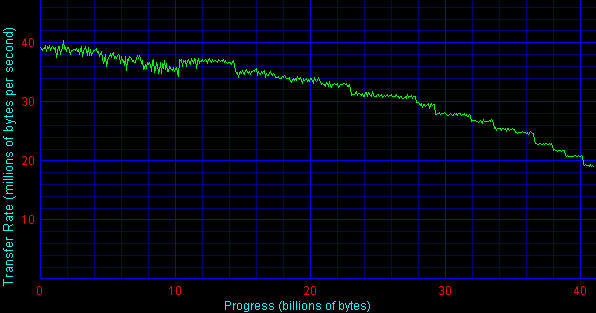 60GXP - NTFS 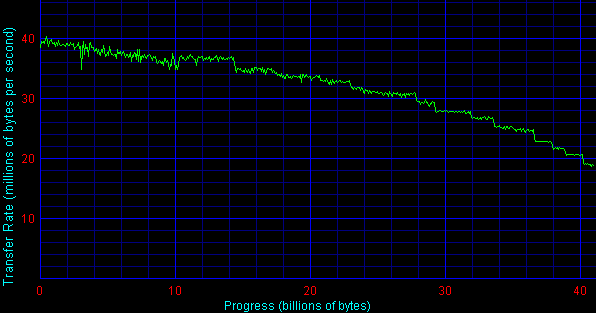 Well, I understand that there are 20 GBytes per platter, 7200 rpm speed but the competitors still manage to perform better somehow! Maybe a delay of the release of this series is connected with the low quality of platters, I don't know. I can't state that since I have tested only one disc. Besides, my colleagues from Storagereview obtained a more even graph of the disc from the same series (it has 60 GB, though). And the situation with the results is clear - the tooth chosen for a readout has defined the result. 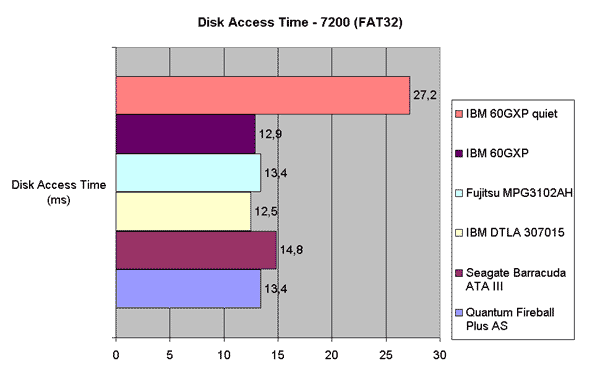 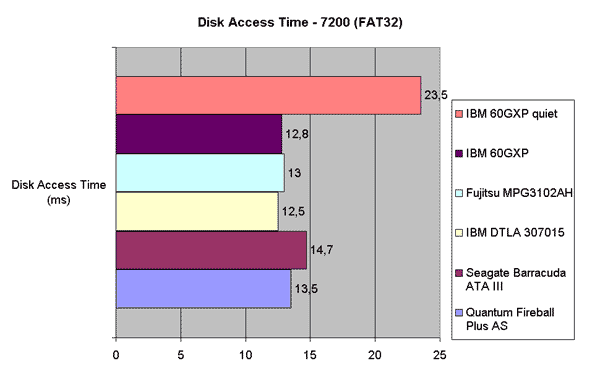 Here, the quiet mode has shown its worth... If in the standard mode it lags not too far behind the leader (the results indicate quite a correlation with the specified data 4.17+8.5=12.67 ms), in the quiet mode the last place raises no doubts. Theoretically, such a difference in the access time must cause a tremendous difference in performance of real applications. Let's check it.  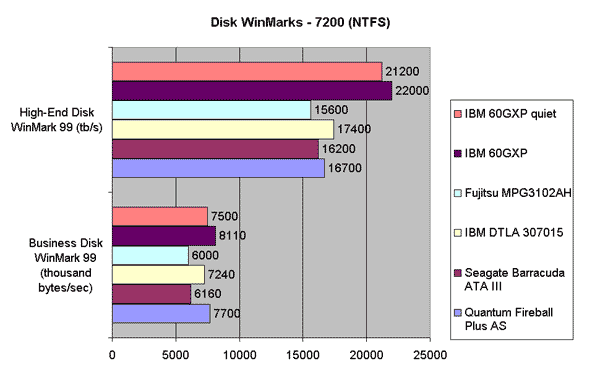 No, it turned out to be wrong! When working with FAT32 the difference is practically absent. But the High-End WinMark test results are very good. Among the results in definite applications I want to mark Sound Forge 4.0 - it is almost twice higher than the previous record of Quantum Fireball Plus AS (23700 tb/s) - 42100 tb/s in the standard mode. When working with NTFS the difference is not very big. On the whole, there is a new leader in the Disk WinMarks test. The complete table of results is here. Intel IOMeterYou can get the proper information on this test in the technique description. Here you can see the complete results, and below are the graphs of the data transfer rate vs. the load for each access pattern.  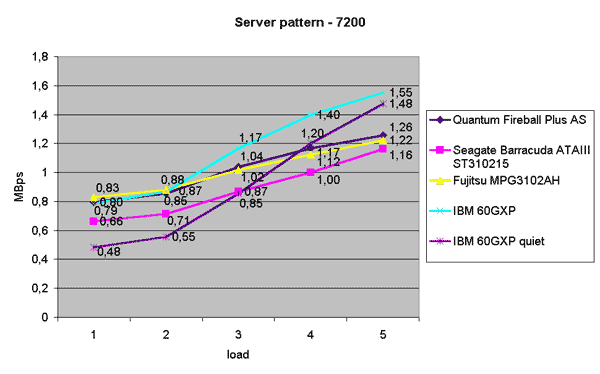  As far as I can judge, the results are influenced by two major factors - the disc access time and quality of firmware algorithms. And if the access time has the greatest effect at low loads, the firmware starts playing a vital role with an increase in the number of I/O requests. It can be seen in the graph of IBM GXP60 in the quiet mode - falling at low loads and a sharp rise with an increase in the load. This proves that the quality of the electronics and firmware of IBM's discs is still high. Apparently, this can account for the lack of the significant difference in the High-End WinMark test results - modern multimedia applications ensure Heavy load (point 5 in the graph). Temperature modeFrankly speaking, I didn't want to measure the disc temperature due to the lack of a special camera with a steady climate. But I had to... I have carried out the measurements with a thermistor screwed into the middle housing of the disc's side surface with the usage of Motherboard Monitor 5.0 program. The temperature has been measured after the completion of Intel IOMeter test - nearly 3 hours of active working of the disc. IBM result is 370C If you are interested in the results of disc temperature measurements, it is possible to use professional thermometers from Fluke - please, write, I'm waiting for your proposals. OtherThe previous IBM model - DTLA - didn't like working with controllers which did not support Ultra ATA/100 mode.Though realizing that it is not a thorough testing I've set the mainboard controller to Ultra ATA/66 mode and run the Ziff-Davis WinBench All WinMarks test during 8 hours. There haven't been any failures. I hope they will be absent as well with the controllers on HighPoint chips. ConclusionThe disc is undoubtedly very fast. It is a leader
in speed characteristics. The electronic system works flawlessly.
The only thing I'm concerned about is the platters... The graph is not
so good, especially considering that IBM has never had any problems
with reliability. Anyway, the time will reveal everything the disc
is capable of.
Write a comment below. No registration needed!
|
Platform · Video · Multimedia · Mobile · Other || About us & Privacy policy · Twitter · Facebook Copyright © Byrds Research & Publishing, Ltd., 1997–2011. All rights reserved. |